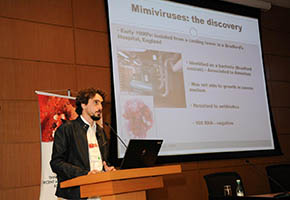

A group of researchers, including Jônatas Abrahão of the UFMG, complete genome sequencing of the Samba virus, the first giant virus isolated in Brazil (photo: Cláudio Arouca)
Researchers have completed genome sequencing of the Samba virus, the first giant virus isolated in Brazil.
Researchers have completed genome sequencing of the Samba virus, the first giant virus isolated in Brazil.

A group of researchers, including Jônatas Abrahão of the UFMG, complete genome sequencing of the Samba virus, the first giant virus isolated in Brazil (photo: Cláudio Arouca)
By Elton Alisson
Agência FAPESP – A type of virus discovered in the early 1990s and since found in various locations has challenged the concepts of microbiologists with regard to this infectious agent as a result of its size and complexity.
The so-called “giant virus” (most viruses are close to 100 times smaller) is a microorganism that is larger than some bacteria, and its genome could have more than 1.2 million base pairs.
Some of the giant viruses isolated in Brazil by researchers in the Giant Virus Prospecting Study Group (GEPViG) at the Federal University of Minas Gerais (UFMG) were presented in a lecture at the International Symposium Biota Microorganisms held at FAPESP on April 29, 2014.
“We conducted studies about the diversity of this type of virus in Brazil and about their evolution and the relationship that these agents have with their hosts and the human body’s immune system,” Jônatas Abrahão, UFMG professor and one of the GEPViG researchers, told Agência FAPESP.
Abrahão explained that a giant virus was isolated in 1992 from a water-cooling tower at a hospital in Bradford, England, but was initially incorrectly identified as a bacterium and associated with amoebas, which are hosts and serve as a reservoir for viral and bacterial replication.
It was only in 2003 that a group of researchers at the Université de la Méditerranée in Marseilles, France, published an article in the journal Science, identifying the microorganism as a type of virus called a mimivirus.
Since then, other giant viruses, such as Pandoravirus dulcis, have been identified. P. dulcis was isolated in Chile and Australia and described in another article that appeared in the journal Science in July 2013.
Described this year in the Proceedings of the National Academy of Sciences (PNAS) was another giant virus, Pithovirus sibericum, which was isolated from the soils of Siberia after being frozen for more than 30,000 years.
“Where there are amoebas, especially of the genus Acanthamoeba, it is possible to find this type of virus. Since there are amoebas worldwide – even in the frozen soils of Siberia – we are very likely to find giant viruses everywhere,” said Abrahão.
Examples in Brazil
The Samba virus (SMBV), the first giant virus isolated in Brazil, was found in the Negro River in Amazonas in 2011. The virus, named for one of the most recognized genres of Brazilian music, had its full genome sequenced in 2012 by researchers at the UFMG in partnership with colleagues at Aix-Marseille Université in France.
The genome sequencing analyses of the giant virus isolated in Brazil were described in an article recently published in Virology Journal. “We determined that the Samba virus encodes genes that up to that point had only been observed in cells,” said Abrahão.
“A virus encoding genes related to protein translation is something that affects our understanding of the origin of life and evolution. This is why it is so important to study these ancestral viruses,” he emphasized.
Other viruses identified by the UFMG researchers are the Cipó virus, found in the Serra do Cipó National Park, and the Niemeyer virus, found in Lagoa da Pampulha in the state of Minas Gerais. Despite some similarities, the samples of the two giant viruses isolated in Brazil revealed that they have morphological and genomic differences.
“They have notable differences in terms of size, shape and genomic structure and are found everywhere, regardless of the biome analyzed,” said Abrahão.
According to the researcher, some studies published in recent years suggest that giant viruses can cause pneumonia in humans, but the findings are not yet conclusive.
“There are studies that demonstrate that they are capable of replicating themselves in monocytes in the human lung. But their relationship with pneumonia has still not been completely determined,” said Abrahão.
In an article published in March in the journal Emerging Infectious Diseases, the UFMG researchers described the circulation of the giant virus among wild and domestic mammals in the Brazilian Amazon region.
The article “Samba virus, a novel mimivirus from a giant rain forest, the Brazilian Amazon” (doi: 10.1186/1743-422X-11-95) by Abrahão and colleagues may be read in Virology Journal at www.virologyj.com/content/11/1/95.
The article “Mimivirus circulation among wild and domestic mammals, Amazon region, Brazil” (doi: 10.3201/eid2003.131050), also by Abrahão and colleagues, may be read in the journal Emerging Infectious Diseases at wwwnc.cdc.gov/eid/article/20/3/13-1050_article.htm.
Republish
The Agency FAPESP licenses news via Creative Commons (CC-BY-NC-ND) so that they can be republished free of charge and in a simple way by other digital or printed vehicles. Agência FAPESP must be credited as the source of the content being republished and the name of the reporter (if any) must be attributed. Using the HMTL button below allows compliance with these rules, detailed in Digital Republishing Policy FAPESP.




